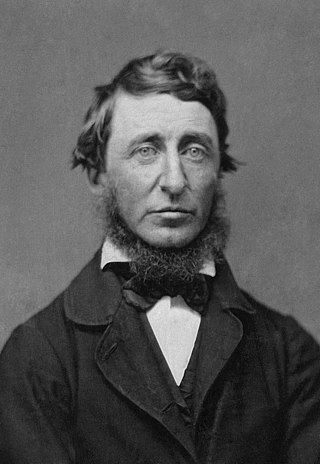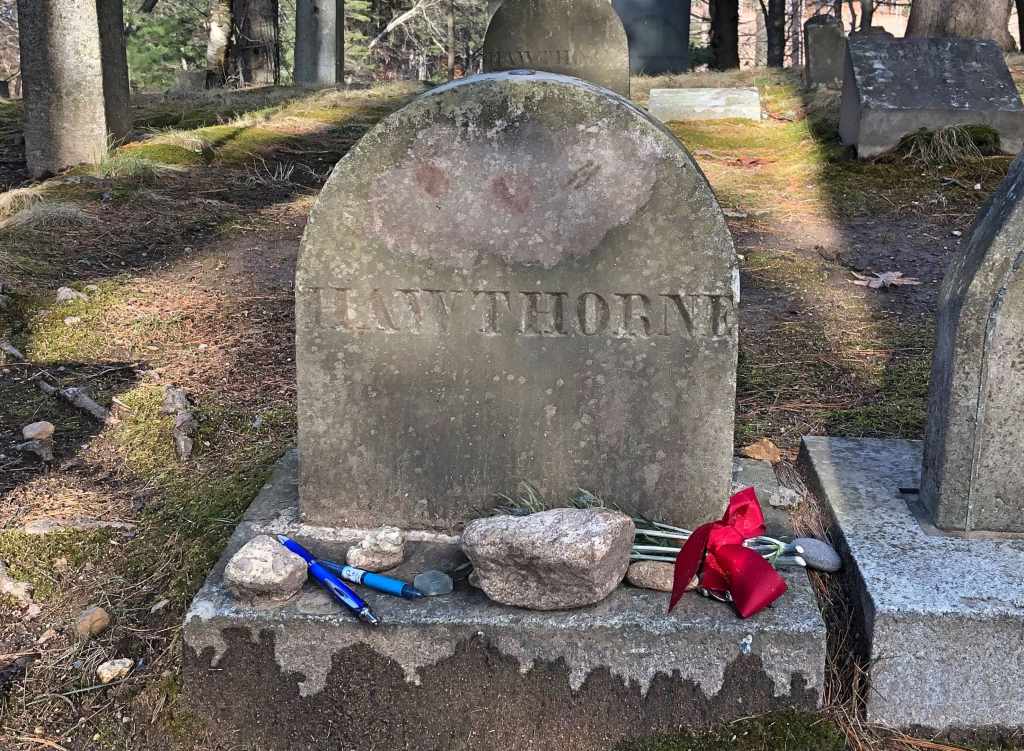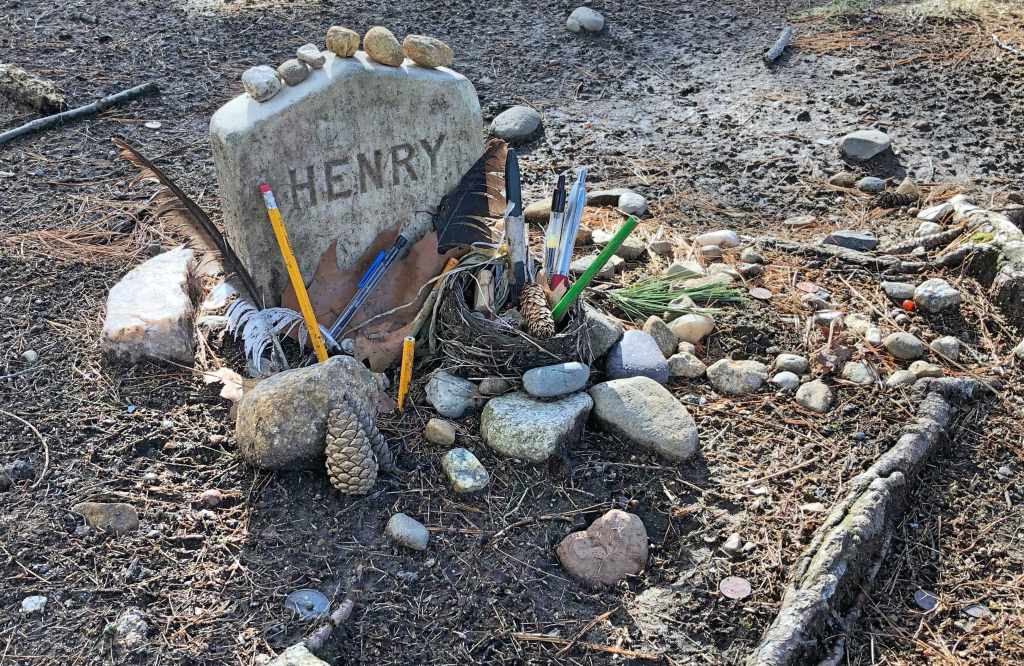I visited Boston by accident. It was a wedding (second cousin, once removed). On a cold December day between Christmas and the New Year, before the nuptial celebrations commenced, I found myself with some time to kill in this historic New England city. So I figured I would use the opportunity to walk the Freedom Trail.
The Freedom Trail is a walking path linking several historic sites in the city of Boston. Most of these have something to do with our Revolutionary War. In the 1770s, Boston was hotbed of rebellious fervor. John Hancock, Paul Revere, and Sam Adams, early advocates for independence, lived here, as did Sam’s more moderate second cousin John. So it was here that the growing dissatisfaction with British rule first spilled out into conflict and bloodshed. This history can be followed as it unfolds along the Freedom Trail.
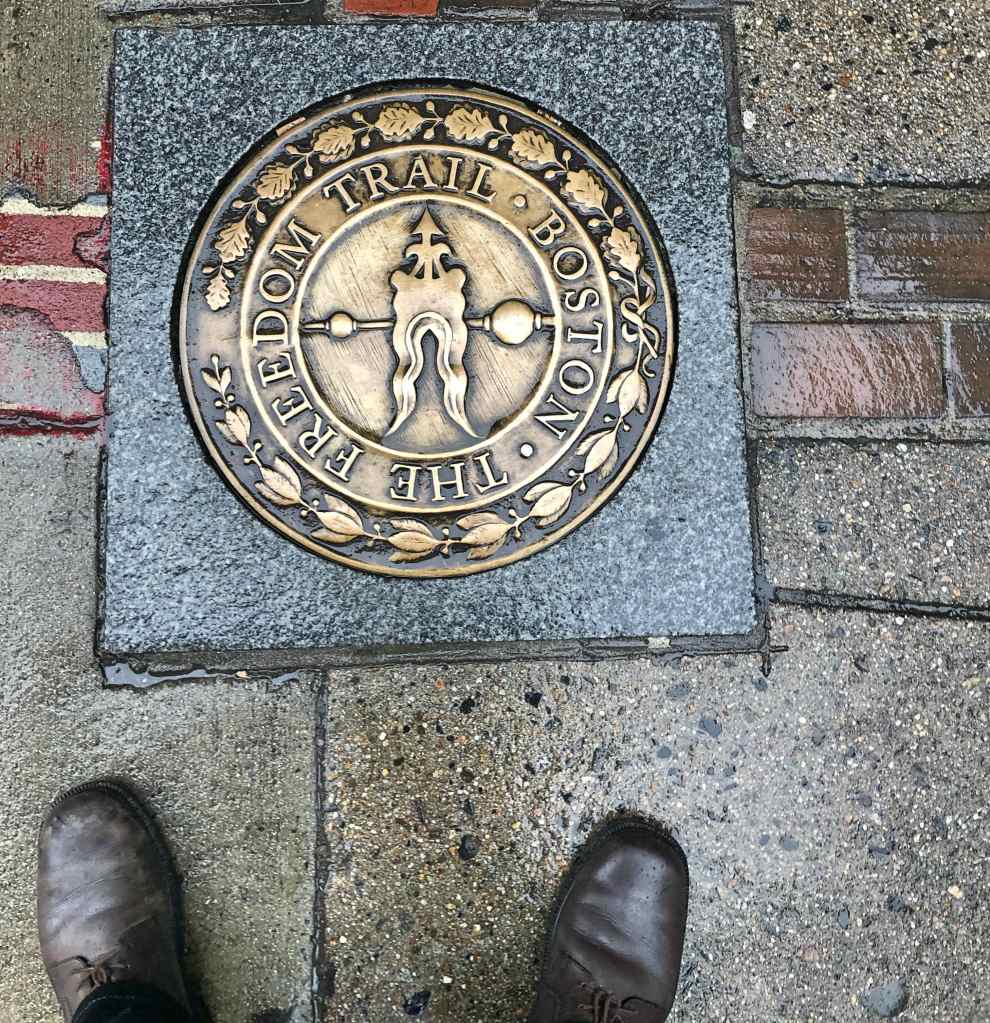
The path begins in Boston Common. This is a park in the center of the city, which holds the distinction for being the oldest public park in the country, as it was opened in 1634. When I visited it was a cold and dreary day, which makes it difficult to judge the park’s comeliness. But overlooking the Common is the Massachusetts State House, a very attractive building designed in the Federal style by Charles Bulfinch, which houses both the governor’s offices and the state legislature.

Standing before this building, on the outer edge of the Boston Common, is the Robert Gould Shaw Memorial. Shaw, as you may know, was the white colonel who led the 54th Massachusetts Infantry Regiment during the Civil War, which was composed of free black soldiers. Allowing black people to serve in the military was considered a radical step at the time; but it also was a kind of symbolic victory over the southerners who were fighting to preserve slavery.

The monument itself was a sensation: its opening was attended by the philosopher William James, the sociologist W.E.B. DuBois, and the educator Booker T. Washington, among other notables. And while the monument did attract criticism during the George Floyd protests—for it portrays the white commander above and in front of his black troops—I think that it was actually radical in its own day. It depicts the black soldiers as dignified, powerful, and fully individual. One need only compare this monument to the Emancipation Memorial (recently removed) in Boston, which shows a black man crouching beneath Lincoln. The soldiers in the Shaw Memorial do not kneel, but march resolutely.

Continuing along the trail, we immediately come upon the Park Street Church, a very attractive place of worship built in the first years of our Republic. Nextdoor is the Granary Burying Ground, so named because a granary used to occupy the space where the church now stands. The visitor enters through a mock-Egyptian gate into what is the third-oldest cemetery in Boston (founded in 1660). Quite a few heroes of the American Revolution are buried here. There is Samuel Adams (1722 – 1803), the aforementioned firebrand who helped to spark our rebellious spirit, as well as Paul Revere (1734 – 1818) of Midnight Ride fame. Aside from Adams, two more signers of the Declaration of Independence are in attendance: Robert Treat Paine (little remembered these days) and the man whose name survived in his oversized signature, John Hancock (1737 – 1793).
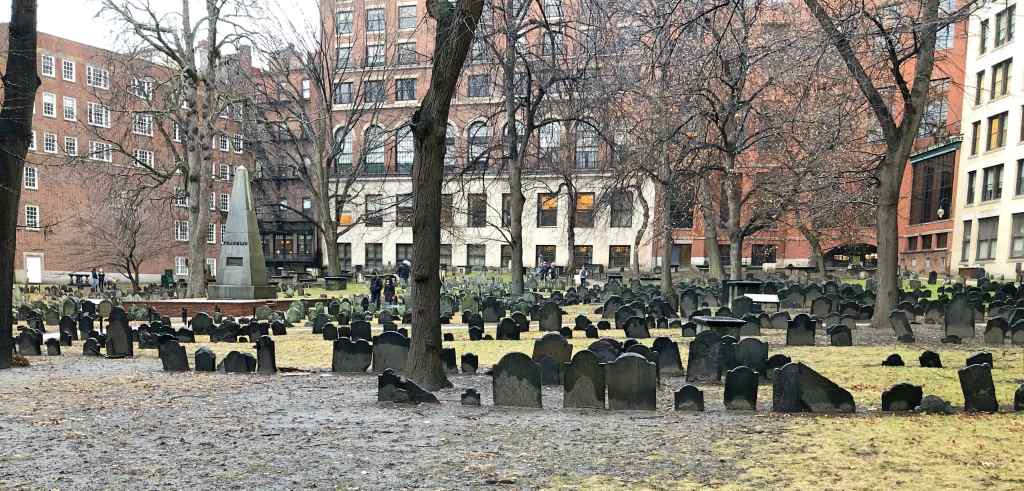

But that is not all. All five victims of the Boston Massacre are buried here. To recount the event dispassionately: An inflamed mob started to throw stones and other things at a garrison of British Soldiers, one of whom fired without orders, causing his comrades to follow suit. Five Americans died from the gunshots. John Adams, who was simply a lawyer at the time, took it upon himself to defend the British soldiers in court, and for the most part succeeded. But the massacre was a decisive step on the road to revolution, as it mustered colonial support more effectively than any speech could. As it turns out, citizens tend to be upset when the forces meant to protect them instead shoot them dead.
The next stop on the trail is another church and burying ground. King’s Chapel is a lovely stone church designed by Peter Harrison, one of the first trained architects to work in the American colonies. Next door is the King’s Chapel Burying Ground, which actually predates the church by over a century, as it is the oldest cemetery in all of Boston (established in 1630). The cemetery does not contain as many famous bodies as the Granary Burying Ground, but some names stand out for comment. Mary Chilton (1607 – 1679), supposedly the first woman to step foot in New England from the Mayflower, was laid to rest here, as was John Winthrope (1587 – 1649), the third governor of the Massachusetts colony. But most consequential may be Frederic Tudor, the so-called “Ice King,” who made a business cutting and shipping blocks of ice from the frigid ponds of Massachusetts. This was both a major innovation and an inspiration for the refrigeration that all of us now take for granted.
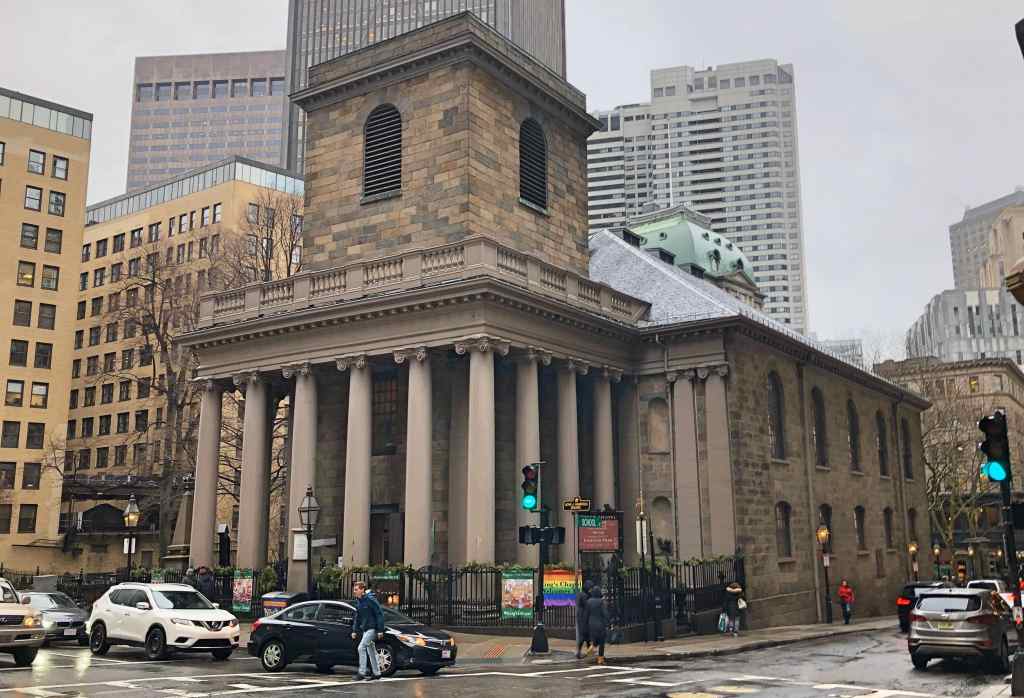
The next stop, just down the street, is the old site of the Boston Latin School. This is a venerable institution of public education—indeed, the oldest public school in the United States. And it is still active, though it has since moved to more ample accommodations than the little building that once stood here. Its presence is marked by an elaborate plaque in the ground. Nearby is a statue of the school’s most famous dropout: Benjamin Franklin. The portly and balding Franklin is honored beside perhaps the most famous mayor of Boston, Josiah Quincy III, whose namesake is the Quincy Market in central Boston. These two eminent men stand before the Old City Hall—serving that purpose from 1865 to 1969—a lovely old relic built in the French Second Empire style
Continuing down the street, we reach the Old Corner Bookstore. This is an attractive brick building, built in 1718 to be used as an apothecary shop with an attached residence. The place became a bookstore in 1828; and shortly thereafter, starting from 1832 and on to 1865, it was used by Ticknor and Fields, a publishing company. Though long forgotten, Ticknor and Fields published some of the most significant American writers of the day, including Emerson, Hawthorne, and Longfellow. They even published Dickens’s books in the United States. As a result, this humble building came to be a meeting place for men (and women) of letters. Unfortunately, after such an illustrious history, this noble edifice is now the home of a Chipotle restaurant. Meaning no offense to big burrito lovers, I will venture to say that this building deserves better.

Right nearby is the Boston Irish Famine Memorial. This is a group of statues—two families of three—that contrasted the lives of those who left Ireland and those who remained. The family that emigrated is shown happy and healthy, while the family stuck in Ireland is on the verge of death. While the artistic merits of the memorial are not beyond dispute, it is certainly right to have a monument to the Irish in Boston, as the city was dramatically shaped by the influx of Irish in the 19th century. Indeed, Boston reminded me of no city more strongly than Dublin—its brick architecture, tight and chaotic streets, and dour atmosphere. At a glance, one could easily mistake historic Boston for the capital of Ireland.
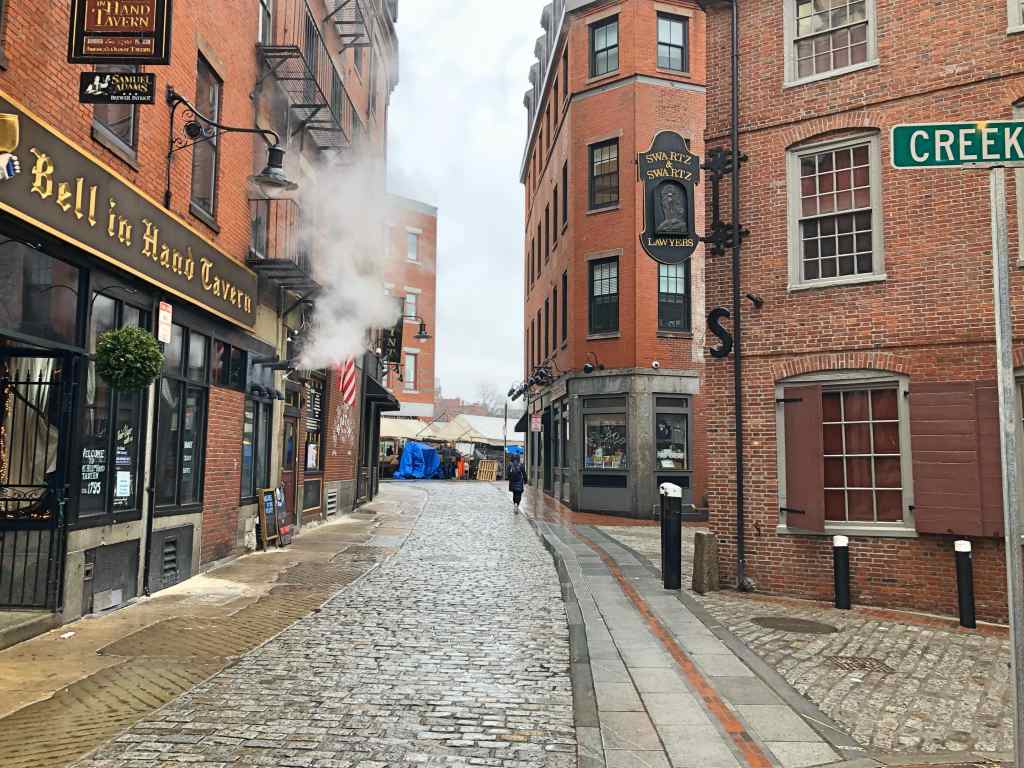
Next on the trail is the Old South Meeting House. This is a plain but elegant brick Congregational church, with a tall white wooden spite—a typical New England aesthetic. The whitewashed interior is filled with boxes of pews, arranged like an enormous maze. This church is not notable for its aesthetic, however, but for its role in the Revolutionary War. After the Boston Massacre of 1770, annual memorials were held here, complete with fiery rebellious rhetoric. Then, in 1773, thousands of irate colonists met here to discuss the much-hated Tea Act, a tax on imported tea. From here, everyone knows the story: A group of a few dozen colonists—some dressed as Native Americans—raided three English merchant vessels in the harbor, and chucked all the tea overboard. This was the Boston Tea Party

Soon we come to the Old State House. And here, the contrast between the old and the new Boston is quite apparent, as this erstwhile commanding structure is now completely dwarfed by the buildings and skyscrapers all around it, in what is now the financial district. But the building is still attractive and graceful. As the name suggests, this building served as the original Massachusetts State House, before it was replaced by the current one (described above). Indeed, built in 1713, the Old State House was used for government affairs long before independence, making it one of the oldest public buildings in the country. Nowadays it is the home to a museum; but I admit the entry fee put me off, and I only browsed the gift shop—filled with the expected touristy stuff. Notably, the museum has a vial containing some tea from the Boston Tea Party, snuck into a raider’s boot. The site of the Boston Massacre is commemorated nearby, in the form of a stone circle.
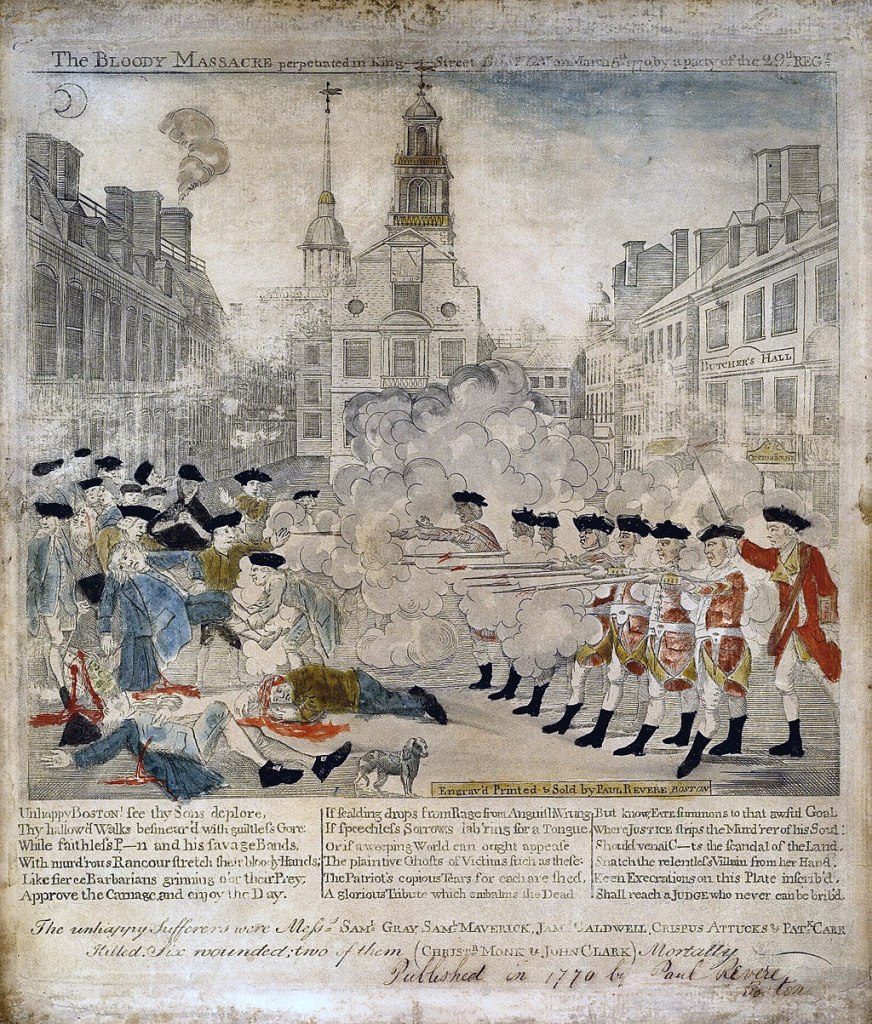
Now we enter Government Center, the part of town where we can find the modern City Hall. Unfortunately, this enormous hunk of brutal concrete compares quite unfavorably with the pretty constructions we have seen so far. Apparently gaining our independence did not advance our taste. The contrast is immediate when we turn our attention to our next stop, yet another big brick building with a white spire: Faneuil Hall. This building served as both meeting house and marketplace in colonial Boston. Firebrands like Samuel Adams gave seditious speeches in the building’s Great Hall, a task for which he is now commemorated with a nearby statue. Faneuil Hall owes its name to a slave trader, who sponsored the project with his ill-gotten gains. Slaves were even sold here. But that original building mostly burned down in 1761, passing along its name to the current edifice. So far, activists have not succeeded in changing its appellation.
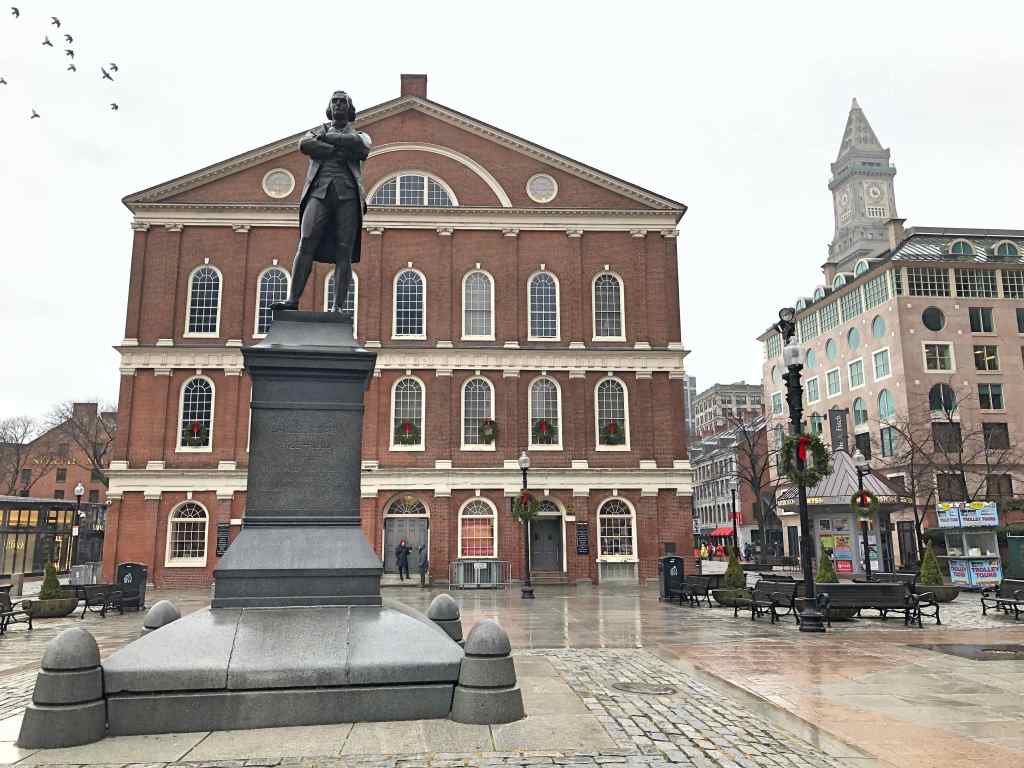
The building’s Great Hall—an enormous auditorium filled with wooden chairs—is now decorated with portraits, paintings, and other sorts of patriotic paraphernalia. It is still used for meetings, organizing, and ceremonies. “Faneuil Hall” is not only used to refer to this building, however, but sometimes to this entire area, a hub of nightlife and a great place to grab a bite to eat. This is partly because the old marketplace has been supplemented by the enormous Quincy Market, named for the Quincy mayor we met earlier. This is a long, open building filled with food stalls and a fair share of touristy junk. I enjoyed walking through the busy space, as it at least provided some respite from the cold.
From Government Center, we now walk to North End, the oldest residential neighborhood in the city. As you will probably notice, this area became popular with Italian immigrants, resulting in the plentiful restaurants serving pizza and pasta. More relevant to the Freedom Trail, this neighborhood is also home to Paul Revere’s House. The house actually predates the famous revolutionary by quite a lot: built in 1680, the house was not bought by Revere until 1770. Though the three-storey, timber house does not look like much to the modern eye, at the time it was both spacious and luxurious, befitting Revere’s status as a prosperous silversmith (there are examples of his work inside). Sold by Revere, and subject to the whims of the market—among other things, it was used as a shop and a tenement—the property was eventually bought by Revere’s grandson, who began the process of restoring it and turning it into a museum. Nowadays, one must pay to enter. Freedom has its price, after all.
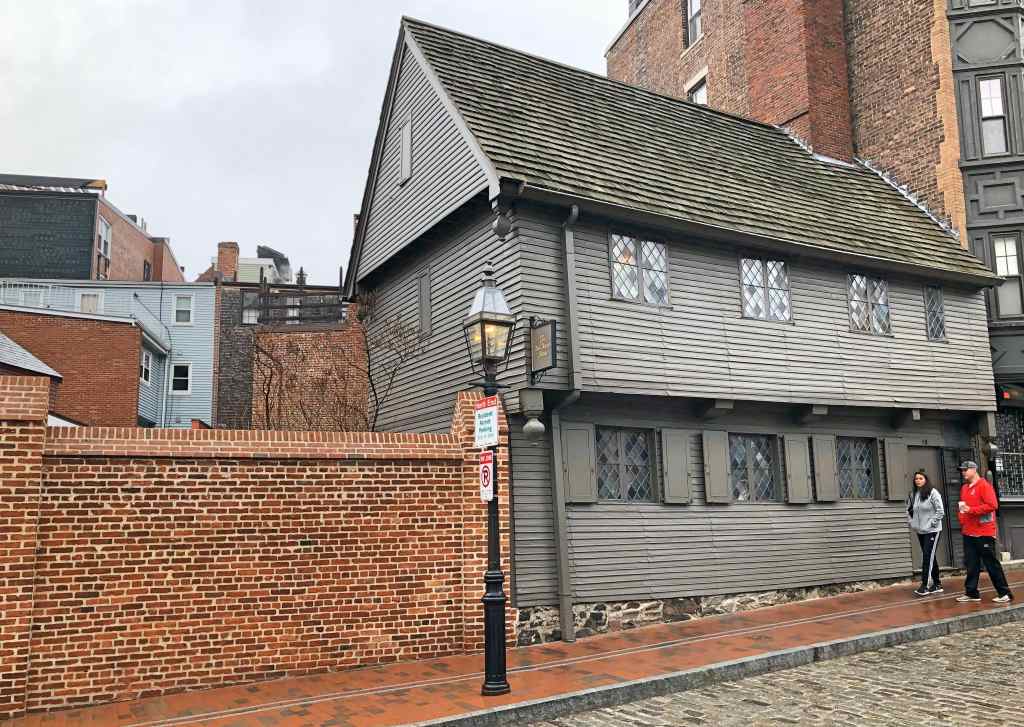
Onward, we reach the Old North Church. Once again, we are confronted with a big brick church with a white spire, whose whitewashed interior is filled with wooden boxes for pews. But perhaps the Old North Church does deserve credit for originality, as it is the oldest extant church in Boston. The competition is close: built in 1723, the Old North Church beats the Old South Meeting House by six years. This church was where the iconic lanterns of Paul Revere’s ride—one if by land, two if by sea—were so briefly hung, in order to warn the colonial militia of the approach of the British Army. Revere himself rode his horse to deliver the message to the troops waiting in Lexington and Concord, though he almost certainly was not shouting “The British are coming!” as that would have blown his cover. As it was, Revere was still arrested by the British, and very nearly executed. His patriotic messenger service is now commemorated by a statue of the man on horseback.
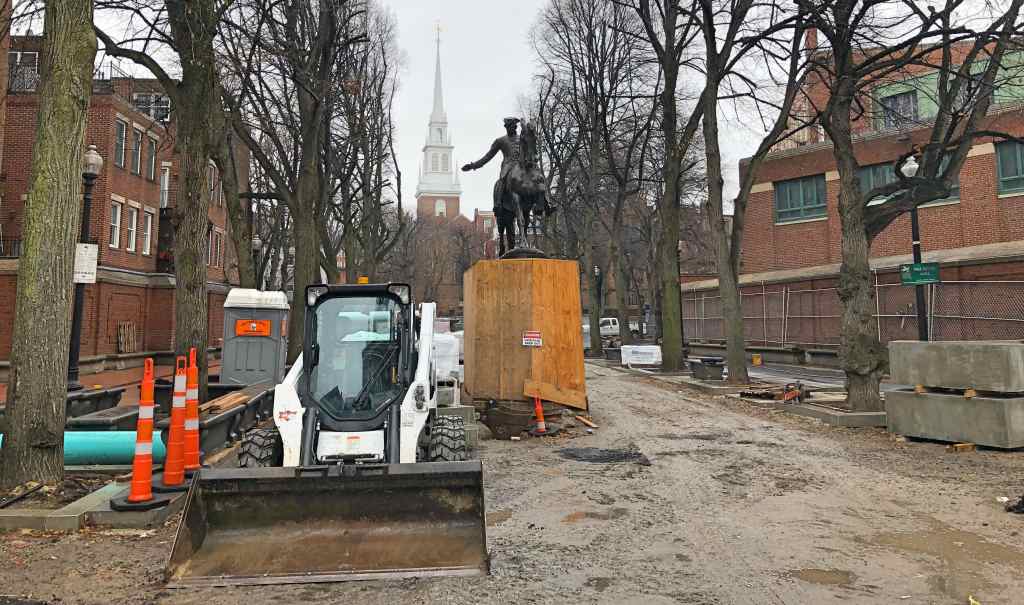
Now we come to yet another cemetery, the Copp’s Hill Burying Ground. As its name suggests, this is situated on a slight hill, giving the visitor a decent view of the River Charles. Founded in 1659, Copp’s Hill is the second oldest cemetery in Boston (29 years after King’s Chapel, but one year before the Granary), and it has its fair share of venerated bodies. Paul Revere’s less-famous fellow rider, Robert Newman, is interred here, as is the poet Philis Wheatley, the first African American woman to be published. But Copp’s Hill is more appealing simply for its landscaping, providing a much-needed relief to the crowded stone and brick streets of Boston. I consider myself something of a connoisseur of cemeteries, and Copp’s Hill is a fine one.
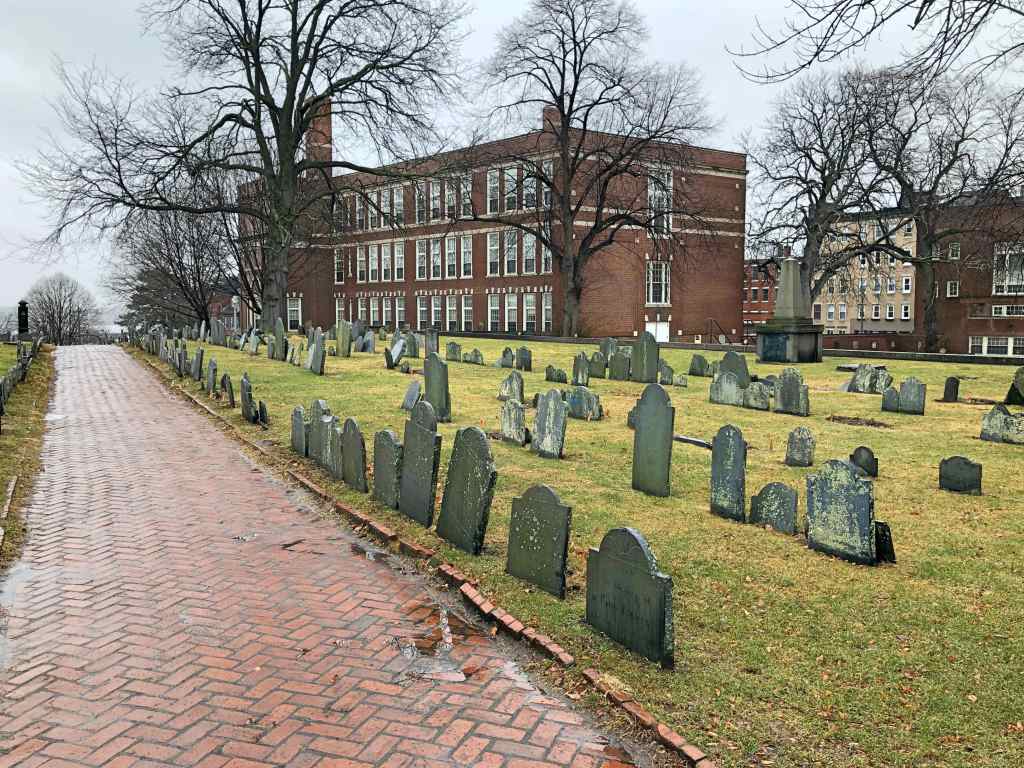
We have a bit of a walk now, as the next stop on the Freedom Trail is across the Charles River. This means walking across the North Washington Street Bridge, which connects North End with the Charleston neighborhood. It would be an exaggeration to say that the bridge is a beautiful piece of engineering, or that the view from the bridge is quite breathtakingly beautiful—especially on a cold, windy, drizzly December day—but I still managed to enjoy the walk. Once across, you turn right towards the wharf, where you may spot the top mast of the next stop in the distance: the USS Constitution.

Now, as it happened, I was visiting Boston during the 2018-19 government shutdown. As a result, the museum attached to this historic war vessel was not open. Visitors were, instead, hastily ushered through metal detectors onto the dock by military personnel (presumably working without pay). In any case, I was able to climb aboard the old ironside and enjoy the charm of an antique vessel. The history of this ship takes us back to the very beginnings of our nation, as it was one of the first six commissioned by the new United States government. Indeed, the Constitution is now the oldest commissioned naval vessel that is still seaworthy. The frigate—equipped with 50 canons—saw significant action during the war of 1812, when it overcame five British warships. This earned the boat legendary status, and it has been kept in good working order ever since. In fact, the boat still has its own 60-person navy crew.

After taking in my fill of the winds and waves, I made my way to the last stop on the Freedom Trail: the Bunker Hill Monument. As you may know, the Battle of Bunker Hill was one of the first and most important of the Revolutionary War. Though the British succeeded in driving the colonial militia from their positions, in their assaults on the rebel position they took heavy casualties, losing far more men than their untrained opponents. According to legend, it was during the first British charge when Col. William Prescott instructed not to fire until they saw “the whites of their eyes.” Unfortunately, there is scant evidence that this dramatic phrase was uttered, and it does seem like a needlessly poetic battle command. What is more, though universally known as the Battle of Bunker Hill, most of the fighting was done on the nearby Breed’s Hill. And this is where the inaccurately-named Bunker Hill Monument is to be found as well.
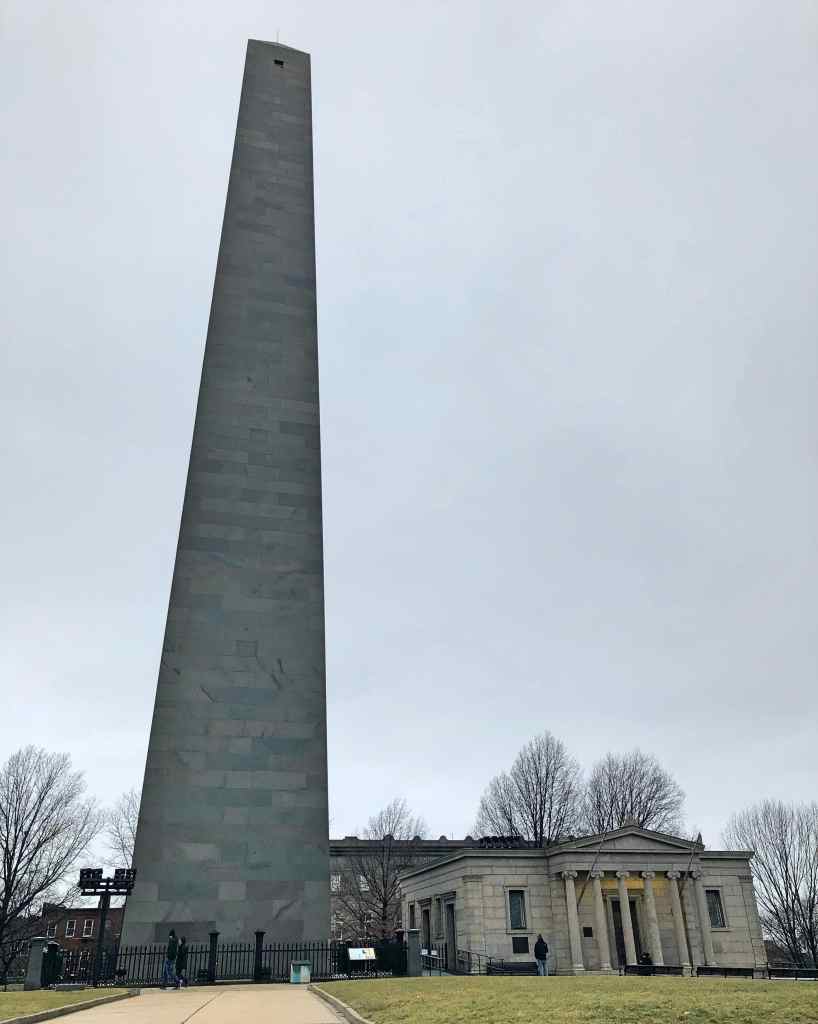
Built from 1825 to 1843 (they frequently had to stop due to depleted funds), the Bunker Hill Monument is one of the oldest national monuments in the country. And its design was influential. Standing on top of the mound of green earth, a granite obelisk juts 221 feet (67 m) into the air. This design almost certainly provided the inspiration for the tower’s more famous cousin, the Washington Monument. The stone was taken from a quarry in the town of Quincy (the town named after Abigail Adams’s grandfather) and transported to the site via one of the first railroads in the country, the Granite Railway. A statue of Prescott stands in front of the obelisk, not too far from where he likely stood during the battle, looking fearsome and fearless. There is an exhibit lodge next to the obelisk, too, though it was closed due to the shutdown. At least the view was still available—revealing the spires of downtown Boston, the cozy houses of Cambridge, and the industry across the river Charles.

I was very cold by now. My clothes soaked through from the rain, and there was a long walk back to the hotel. But my misery was punctuated by a stop at a restaurant in Chinatown, where I had some delicious noodle soup. Then it was time to shower and get my suit ready for the wedding. And that was it. So, unfortunately, I saw very little of Boston during this trip. I was particularly sorry not to see Boston’s Museum of Fine Arts, one of the finest art museums in the country. But what I had seen, during my few hours of exploration, was enough to motivate me to walk several miles in soggy shoes. And that is a pretty high compliment.






